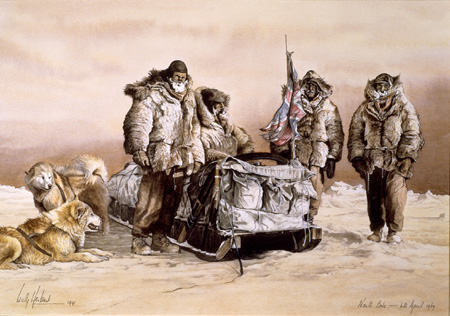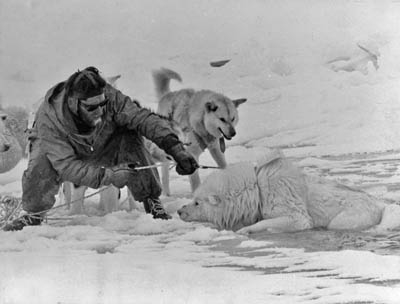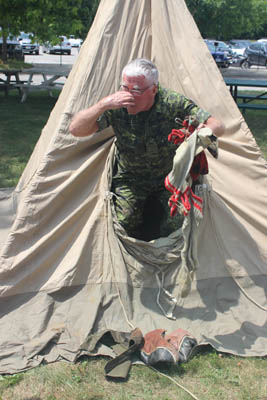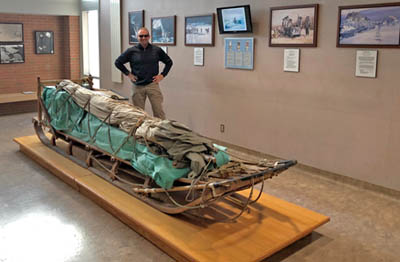In this Post
From the
Editor
The Aboriginal Dog as a Domesticate
Neuroanatomy and Behavior Correlations
Specialized Sledge Dogs Accompanied Inuit Dispersal Across the North American Arctic
Cold Case Reopened and Other QIMMEQ News
Langsomt på Svalbard (Slowly on Svalbard)
Frossen Frihe (Frozen Freedom)
Restoring a Historic Nansen Sledge
Media Review: Kamik, an NFB documentary
IMHO: A View from Across the Divide
The Aboriginal Dog as a Domesticate
Neuroanatomy and Behavior Correlations
Specialized Sledge Dogs Accompanied Inuit Dispersal Across the North American Arctic
Cold Case Reopened and Other QIMMEQ News
Langsomt på Svalbard (Slowly on Svalbard)
Frossen Frihe (Frozen Freedom)
Restoring a Historic Nansen Sledge
Media Review: Kamik, an NFB documentary
IMHO: A View from Across the Divide
Navigating This Site
Index of articles by subject
Index of Journal editions by
volume number
Index of PostScript editions by publication number
Search The Fan Hitch
Articles to download and print
Ordering Ken MacRury's Thesis
Our comprehensive list of resources
Defining the Inuit Dog
Talk to The Fan Hitch
Shop & Support Center
The Fan Hitch home page
Index of articles by subject
Index of Journal editions by
volume number
Index of PostScript editions by publication number
Search The Fan Hitch
Articles to download and print
Ordering Ken MacRury's Thesis
Our comprehensive list of resources
Defining the Inuit Dog
Talk to The Fan Hitch
Shop & Support Center
The Fan Hitch home page
Editor's/Publisher's
Statement
Editor: Sue Hamilton
Webmaster: Mark Hamilton
The Fan Hitch Website and
Publications of the Inuit Sled Dog– the
quarterly Journal (retired
in 2018) and PostScript – are dedicated to the aboriginal
landrace traditional Inuit Sled Dog as well as
related Inuit culture and traditions.
PostScript is
published intermittently as
material becomes available. Online access is
free at: https://thefanhitch.org.
PostScript welcomes your
letters, stories, comments and suggestions.
The editorial staff reserves the right to
edit submissions used for publication.
Contents of The Fan Hitch Website and its publications are protected by international copyright laws. No photo, drawing or text may be reproduced in any form without written consent. Webmasters please note: written consent is necessary before linking this site to yours! Please forward requests to Sue Hamilton, 55 Town Line Rd., Harwinton, Connecticut 06791, USA or mail@thefanhitch.org
Contents of The Fan Hitch Website and its publications are protected by international copyright laws. No photo, drawing or text may be reproduced in any form without written consent. Webmasters please note: written consent is necessary before linking this site to yours! Please forward requests to Sue Hamilton, 55 Town Line Rd., Harwinton, Connecticut 06791, USA or mail@thefanhitch.org

North Pole water colour
by Wally Herbert.
Left to right: Wally Herbert, Roy Koerner, Allan Gill, Kenneth Hedges
This stunning print and many others are available at Polarworld
Courtesy of Kari Herbert; Copyright of the Wally Herbert Collection
Left to right: Wally Herbert, Roy Koerner, Allan Gill, Kenneth Hedges
This stunning print and many others are available at Polarworld
Courtesy of Kari Herbert; Copyright of the Wally Herbert Collection
The
Restoration of a Historic Nansen Sledge
by John Wright
with input from Dr. Ken Hedges
by John Wright
with input from Dr. Ken Hedges
The Fan Hitch Journal Vol.12, N4, September 2010 detailed the memories of Dr. Ken Hedges relating to the British Trans Arctic Expedition, 1968 – 69.
The Expedition comprised of Wally Herbert (Leader), Allan Gill (Navigator and cameraman), “Fritz” Koerner, PhD (Glaciologist) and Major Ken Hedges (Physician seconded from the British SAS). Herbert was to receive a knighthood some thirty years after the completion of the expedition in the 2000 Millennial Honours List for services in polar regions. The crossing was recorded in contemporary editions of the Guinness Book of Records as:
- The first crossing of the surface of the Arctic Ocean.
- The first undisputed expedition to reach and return from the geographic North Pole across sea ice.
- The longest sustained dogsled journey on sea ice in the history of Polar exploration (covering an estimated 6,000 kilometres over 476 days).
Replacement sledges were air dropped to the team with the second resupply. It's clear from photographs taken at the end of the expedition that at least one komatik was helicoptered onto HMS Endurance. However, it was a Nansen that Ken left behind to make a dash with Allan Gill across shifting ice floes to scramble ashore on Vesle Tavleoya, a small island in the Svalbard archipelago, thus completing the crossing. Ken suspects that at this point they had two Nansens and two komatiks.

Ken hauling his boss dog "Uncle Wal" out of a pool of open water towards
the end of the expedition. Photo courtesy Ken Hedges
After reuniting with their sleds and the remainder of the team, all were picked up by helicopter and flown to HMS Endurance which then returned them to the UK. Ken’s sledge and part of its load went into storage at the Royal Army Medical Corps Museum and over the years became largely forgotten.
Fast forward to 2013. Ken had first visited Canada in 1937 (at the age of two) from his childhood home in the Fiji Islands. He subsequently migrated to Canada with his bride, Dawn, in the 1970s. In 2010 he became the first Honorary Colonel of the Royal Canadian Medical Service appointed by the Minister of National Defence to serve at the Canadian Forces Health Services Training Centre, Canadian Forces Base Borden.
Ken and I are old friends, having met when I was a British exchange officer at Borden. Like Ken, I subsequently moved to Canada. He contacted me to say his sledge had been transferred to the Canadian Forces and was to form the centre piece of an Arctic display at Borden. Would I help him to refurbish it?
Having experience with Nansens through the British Antarctic Survey (BAS) and working with Roger Daynes who produced Nansens in the UK, it was a great opportunity to help conserve a piece of polar history.

Polar medalists Hon. Col Ken Hedges (Right) and
Maj (Ret.) John Wright consider the restoration of
Ken's BTAE Sledge. Photo courtesy of: Canadian
Forces Health Service Training Centre.
It immediately became apparent that this was no ordinary Nansen. It had the same general construction as a standard BAS dog sledge but it was wider and generally of much heavier construction. The bridges were laminated and deck of the sledge was slightly swept up at the front. Boards had been fixed under the bridges to protect the entire underside. The handlebars at the rear were perhaps a little lower than usual and there was a platform below them to give another option for positioning the driver who would usually have to run or ski alongside.
The sledge looked as though it had just come off the ice and it showed signs of hard wear. Some damage would no doubt have been repaired in the field were it not for the imminent pick up by helicopter. In particular the joints on one of the bridges were so worn that it was almost detached from the runner and the cow catcher was detached and broken. Wanting to present the sledge as it was used on the expedition, we restricted our restoration to repairs that we could have made in the field. These consisted of replacing a few broken lashings, splicing broken components and re-fixing the loose bridge and cow catcher with hide lashings supplied by Roger Daynes. The result is a sledge that with the addition of a dog team could still cover a few miles.
When we started work on the sledge Ken casually mentioned that it had been returned complete with part of its load, consisting of a few sledge boxes and a tent but he hadn’t yet examined them. On doing so we discovered a few cooking pots and a primus stove but the real treasure lay in the tent. It was a standard BAS Scott pyramid tent and I suggested we should erect it. We did so in front of a crowd of bemused Medical Service personnel and I suggested that Ken should be the first into the tent. As he disappeared into the tunnel entrance, I jokingly suggested that he would probably find his old socks hanging in the top. A moment later he reappeared – complete with a collection of socks, gloves and a hat!

After 44 years since his tent was last unpacked and erected,
Ken Hedges emerges with his well-worn socks, gloves and hat!
Photo courtesy of Canadian Forces Health Services Training Centre

Restoration complete, Police Inspector Johnnie Kelsall stands by Ken Hedges'
Nansen sledge Photo: Ken Hedges
On return from the Antarctic John taught outdoor pursuits before joining the Educational and Training Services Branch of the British Army. He climbed and skied in various parts of the world including the Arctic and later transferred to the Canadian Army. He was awarded the British Polar Medal with Arctic and Antarctic clasp in 1999. He retired in 2012 and now runs a small Polar Supplies company and guides on cruise ships in the polar regions.
*
Ed: As many readers may be
curious about the dogs, here is what John Wright quoted
from Sir Wally Herbert’s book:“The forty Greenland Huskies had been purchased on behalf of the expedition by Inspector Orla Sandborg over a period of several weeks from the many isolated Eskimo villages which are in his care and jurisdiction in the Thule District of North-West Greenland and these were collected by Allan and Ken over the Christmas period of 1967.
They were collected from the air force base at Thule by RAF Hercules on 6th Jan 1968."
In the creation of Wright’s article, Ken Hedges commented, “As a matter of interest they were vaccinated against rabies and during the work up period they killed a fox. Analysis later proved the fox to be rabid so it was a wise precaution.” Hedges further explained, “At expedition’s end, the dogs went into quarantine for six months in Spitzbergen. Ken's team then went to The Norsk Trekhund Club - The Norwegian Mountain Rescue Club. The remaining teams remained in Spitzbergen and presumably found new homes. It would be nice to think that the genes of these dogs live on in Norway and Spitzbergen.”
Read a review of Across the Top of the World here. Copies are available on the secondary market from online booksellers